
Publisher:
Bonnie King
CONTACT:
Newsroom@Salem-news.com
Advertising:
Adsales@Salem-news.com

~Truth~
~Justice~
~Peace~
TJP
Feb-12-2011 17:25

 TweetFollow @OregonNews
TweetFollow @OregonNews
Why New Nuclear Reactor Loan Guarantees are Now More Imprudent than ever
Mark Cooper for Salem-News.comFour Long-Term Factors Significantly Increase the Danger of Defaults for U.S. Taxpayers.
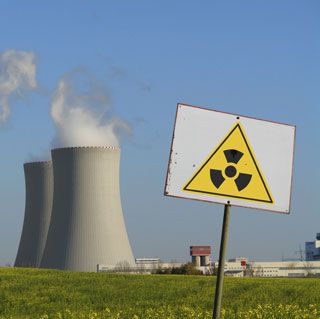 Courtesy: scientificamerican.com |
(SOUTH ROYALTON, Vermont ) - The U.S. is expected to see very soon (1) the awarding of as many as two more loan guarantees for nuclear reactor projects, (2) possible additional nuclear loan guarantee authority in the House FY2011 Continuing Resolution and (3) a proposed increase of nuclear loan guarantees in the White House FY 2012 budget. However, prevailing market trends could not be worse for lawmakers and taxpayers who are concerned about the risk of defaults on any new loan guarantees.
Contrary to what is asserted by proponents of building more new nuclear reactors in the United States, (1) there is no "nuclear renaissance" underway in this country, (2) the beleaguered nuclear industry's chief woes are not regulatory hurdles in Washington, D.C., and (3) calling nuclear power "clean" won't alter the fundamental reality that nuclear power is totally uneconomic.
The nuclear power industry is dead in the water today in the U.S. because nuclear power is simply too expensive. Only a French-style socialist arrangement under which the industry (by government fiat) has unlimited access to taxpayer-backed loan guarantees and the pocketbooks of ratepayers prior to and during the reactor construction process would allow utilities to even contemplate building new nuclear reactors. Even with these massive subsidies their prospects are murky, at best.
Four marketplace developments ended the nuclear renaissance before it began. Those factors are:
| • | Skyrocketing cost of building new nuclear reactors, with no end in sight to the upward spiral; |
| • | Falling natural gas prices that could stay low for decades, as new technologies have dramatically increased the amount of natural gas that is recoverable; |
| • | Lower cost alternatives that are widely available and afford utilities much more flexibility in meeting the need for electricity in an uncertain economic and policy environment. |
| • | Declining demand growth for electricity, with growing evidence that there has been a permanent shift in the pattern of growth; and |
Public policy cannot repeal economic reality. Nuclear economics are so bad that subsidies (in the form of federal loan guarantees or unfunded mandates like a federal "Clean Energy Standard"), as well as the infusion of capital from foreign equipment vendors and/or foreign governmnets, are not enough to kick start reactor construction. The nuclear industry is demanding state ratepayers subsidize and guarantee to pay the construction costs, even if the reactors are not built. The nation does not need -- and the federal government should not force taxpayer and ratepayers to fund -- another multi-billion-dollar bailout of an industry that is totally uneconomic and has no chance of standing on its own.
The following charts vividly illustrate the folly of the federal government taking further steps to make nuclear even more of a "ward of the state."
Factor 1: Nuclear reactors cost much more than the industry projected when it made the case for them. You never hear about a new coal or natural gas-fired power plant costing 100 percent or 200 percent more to build than was initially projected. But low-balled front-end cost projections and rising back-end construction costs are the norm in the nuclear power industry. Not only does the sky-high projected cost of nuclear power make them impossible to finance on Wall Street - and unable to produce price competitive power - but the ever-rising construction costs make them even bigger white elephants. U.S. taxpayers and ratepayers have much to fear if elected officials rush in with direct and indirect subsidies where Wall Street fears to tread. The industry understated its initial cost projections in order to get a seat at the energy policy table, counting on being able to stick taxpayers and ratepayers with the inevitably much higher price tag at a later date.
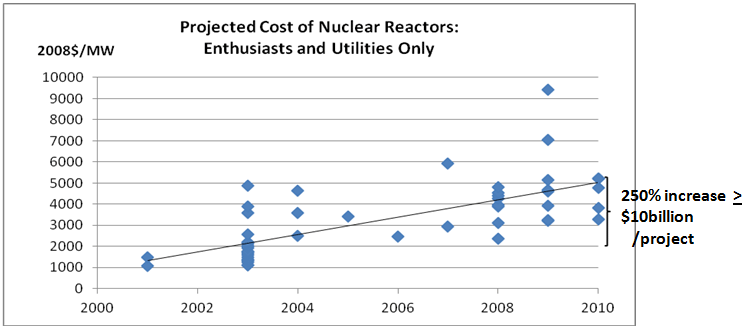
Sources: Cooper, Mark, Policy Challenges of Nuclear Reactor Construction, Cost Escalation and Crowding Out Alternatives: Lessons from the U.S. and France for the Effort to Revive the U.S. Industry with Loan Guarantees and Tax Subsidies, September 2010.
Factor 2: Nuclear power simply cannot compete with low-cost natural gas. In a competitive marketplace, natural gas beats nuclear hands down from a price standpoint. This was a major factor in the collapse of the Calvert Cliffs-3 project in Maryland. Studies have shown that if built the South Texas Project - the next candidate in line for a federal loan guarantee - could not deliver electricity cheaply enough to survive. It is the key factor that has led many of the leading nuclear utilities in the U.S. to abandon plans for construction of new reactors.
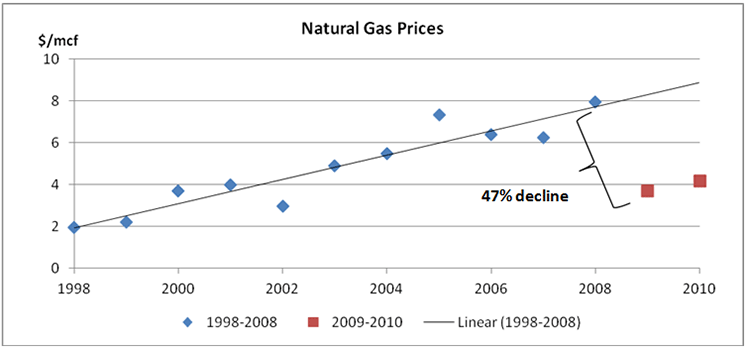
Factor 3: Natural gas is not the only alternative with which nuclear cannot compete. There are numerous lower cost alternatives available to meet the need for electricity whether or not the U.S. adopts policies to reduce carbon emissions in the electricity sector. If technologies are allowed to compete on a level playing field to meet the need for electricity, nuclear reactors would be unable to win in the marketplace for the foreseeable future. Policies that address climate change help most of the alternatives as much as nuclear if not more so. This is a key reason why capital markets will not fund these projects and the industry is so desperate for subsidies.
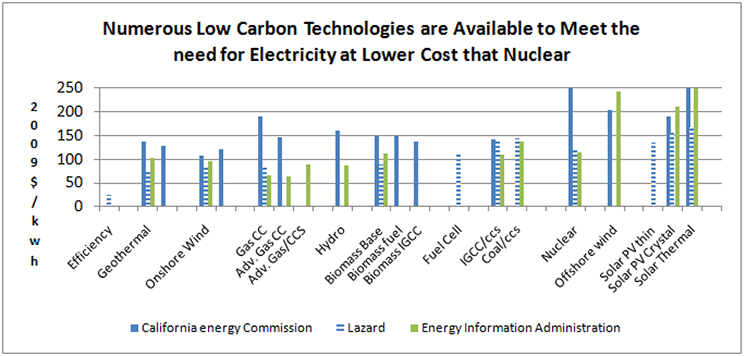
Sources: Energy Information Administration, Cost of New Electricity Generating Capacity in the Annual Energy Outlook, 2011, January 2011; California Energy Commission, Comparative Costs of California Central Station Electricity Generation, January 2010; Lazard, Levelized Cost of Energy Analysis - Version 3.0, June 2009.
Factor 4: Rapidly falling consumer demand for electricity has destroyed the case for many proposed nuclear reactors. While the recession has depressed demand for electricity in the near term, it is becoming clear that a major shift in consumption patterns is taking place, driven in part by the success story of increased energy efficiency. Energy efficiency is the cheapest, cleanest and fastest energy source available today - it is significantly less expensive than nuclear and involves no safety issues, waste disposal problems and lengthy construction delays.
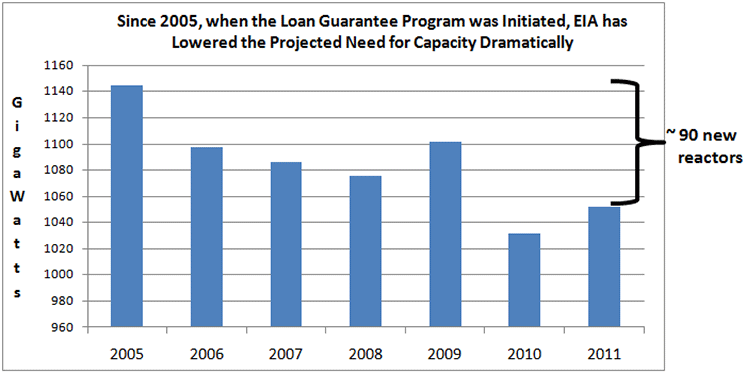
EIA, Annual Energy Outlook, Table A9, various years.
What we have seen in the U.S. nuclear reactor space in the past decade is a classic speculative "bubble." It unfolded in the classic stages: a promotional frenzy (2001-2005 per the streamlining of the licensing process and establishment of the loan guarantee program); a surge in speculative interest (2006-2008, as measured by applications for licenses and loan guarantees) that the industry could not deliver on (as demonstrated by skyrocketing cost estimates); and, finally, the inevitable bursting of the bubble under the weight of economic reality (2009-2010, per plummeting natural gas prices and declining demand growth, resulting in reactor cancelations and postponements). This is a bubble that will one day find itself in the textbooks as an example of market mania on a grand scale.
For detailed background economic analysis, see:
Policy Challenges of Nuclear Reactor Construction, Cost Escalation and Crowding Out Alternatives: Lessons From the U.S. and France for the Effort to Revive the U.S. Industry With Loan Guarantees and Tax Subsidies (September, 2010): http://www.vermontlaw.edu/
All Risk, No Reward for Taxpayers and Ratepayers: The Economics of Subsidizing The 'Nuclear Renaissance' With Loan Guarantees And Construction Work In Progress (November 2009)
http://www.vermontlaw.edu/
The Economics of Nuclear Reactors: Renaissance or Relapse? (June 2010)
http://www.vermontlaw.edu/
Articles for February 11, 2011 | Articles for February 12, 2011 | Articles for February 13, 2011


Quick Links
DINING
Willamette UniversityGoudy Commons Cafe
Dine on the Queen
Willamette Queen Sternwheeler
MUST SEE SALEM
Oregon Capitol ToursCapitol History Gateway
Willamette River Ride
Willamette Queen Sternwheeler
Historic Home Tours:
Deepwood Museum
The Bush House
Gaiety Hollow Garden
AUCTIONS - APPRAISALS
Auction Masters & AppraisalsCONSTRUCTION SERVICES
Roofing and ContractingSheridan, Ore.
ONLINE SHOPPING
Special Occasion DressesAdvertise with Salem-News
Contact:AdSales@Salem-News.com


googlec507860f6901db00.html
Terms of Service | Privacy Policy
All comments and messages are approved by people and self promotional links or unacceptable comments are denied.
Wendall Dennis February 17, 2011 1:15 pm (Pacific time)
Hanford Nuclear Reservation, setting on the banks of the Columbia river, serves is a poster child, for we, the citizens for common sense. Not one estimate exist, of the polution that has seeped into the river in the last seventy years. Billions of dollars has been donated to GE for the development of a vitrification process( turning it into glass)and transporting it to Yuca Depository. And now, although billions more dollars have been spent preparing the site, Arizona citizens yelling "not in my back yard)" have brought the process to a virtual halt. Until Hanford is cleaned up, a Major Disaster, affecting all the citizenry, along the Columbia's banks from Washingtons Tri Cities, to where it dumps in to the Pacific at Oregons Astoria, remains a very real possibility. When Hanford is factored into the equation,the answer is Hell No.
Normand Larocque February 14, 2011 7:42 pm (Pacific time)
The author's economic equations disfavoring nuclear energy are unconvincing. Mechanical fatigue factors relevant to wind and solar energies suggest these long term industries are limited to say the least. Obvious side effects from travel on public highways dwarf by far adverse reactions from nuclear activities. Many major economies are investing greatly to expand their nuclear energy capabilities. I personally am not convinced commercial natural gas supplies are long term options.
Dave Headreader February 14, 2011 4:14 pm (Pacific time)
The big problem with nuclear power is that radiation is not compatible with biological life and reactors mean constant low level leaks and a high level pile of waste that is deadly for thousands of years. There is also an ongoing risk of massive releases in the case of terorist attack, earthquakes, airplane impacts, etc. Now add the spiraling cost and duration of construction as alternatives (natural gas, wind and solar) become less expensive. Finally there is the near certainty that there will be another catastrophic accident amongst the world's aging 1st and 2nd generation plants as they are pushed to the limit under varying degrees of supervision. When that happens it will put all new and uncompleted plants at risk of shutdown. The only reason that nuclear power is promoted is the profits coming from hugely capital intensive contracts that are subsidized and protected from liability by the government, ie unwilling taxpayers.
Fissionary February 14, 2011 6:55 am (Pacific time)
How much do frivolous lawsuits, like those filed by Mr Cooper's fossil fuel-promoting Sierra Club, add to the cost of a new nuclear power plant? Also, I doubt your natural gas turbines will still be making power 60 years from now. New nuclear units will run for 60 or possibly even 80 years. How does that factor into those graphs?
Anonymous February 13, 2011 6:19 pm (Pacific time)
I wonder why France seems to enjoy the cost benefits of their nuclear energy compared to other sources? I wonder why for over 50 years our military has been able to maintain their nuclear powered craft in a far more cost beneficial way than military crafts that use fossil fuel? Not many major accidents or even small ones! Then we have Spain who plowed big bucks into various alternative energy sources, losing hundreds of thousands of jobs (considering their population, that's a lot of unemployed!) by losing their conventional energy jobs, and still have literally no cost benefit. Oh, and now we are seeing our corn prices go up, you know that stuff they are using for ethanol (big failure), and it is also used to feed those critters we like to eat. So with oil prices going up, most all consumer goods will also go up, and then what, rolling brownouts and blackouts. In regards to nuclear energy, we are not Russia, Three Mile Island (no one died) was 30 years ago and our technology is light years advanced. Oh, and the nuke energy an individual would use in a lifetime, the waste would fit into a sode can. Also, our economy runs on energy, so when you have no energy, see how life goes for you then, especially living in a country with over 300 million. You will have to take your comments out to the streets, that is if you are not dealing with a martial law situation, or?
Rod Adams February 13, 2011 3:14 am (Pacific time)
The graph of projected levelized costs of electricity is informative. I wonder if Cooper can explain why the cost projections from the California Energy Commission for nuclear should be given greater weight than the cost projections from the United States Energy Information Agency? If you believe the folks in CA, where new nuclear plants have been outlawed for several decades, you will accept Cooper's assertion that nuclear is too expensive, but if you look closely you will see that the US Energy Information Agency's prediction for the cost of nuclear energy is less than half of the one from CA and is competitive with a wide variety of options - especially those that emit no waste gases. Unlike wind or solar, nuclear also has the advantage of predictable, reliable performance no matter what the weather conditions are.
Rod Adams February 13, 2011 3:06 am (Pacific time)
Cooper writes "You never hear about a new coal or natural gas-fired power plant costing 100 percent or 200 percent more to build than was initially projected." That may be because the coal and gas industry is far better at obscuring reality than the nuclear industry. It may also be because Cooper is not listening or not looking very hard to find the stories. It may also be because coal or gas projects that run into trouble are often abandoned once they start hitting cost caps because the owners know that they will NEVER be able to operate economically due to high marginal fuel costs. Here is a link to some information about Duke Energy's most recent trouble building the Edwardsport IGCC plant, but you can also find historical information about the Polk County IGCC and read all about the FutureGen CCS demonstration issues. http://www.coalage.com/index.php/news/latest/851-new-troubles-for-dukes-edwardsport-igcc-plant.html
[Return to Top]©2025 Salem-News.com. All opinions expressed in this article are those of the author and do not necessarily reflect those of Salem-News.com.